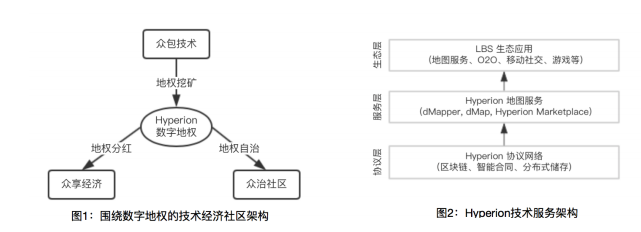-
Cryptocurrencies
-
Exchanges
-
Media
All languages
Hyperion (Hyperion) map public chain is committed to realizing OneMap's convenient map solution through decentralized technology, including map search, map location sharing, and map navigation and other functions.
One Map will provide people with credible, safe and efficient decentralized map data services driven by spatial consensus. Through the organic integration of Hyperion's innovations in three important dimensions of technology, economy, and social structure, the value generated by map data will be returned to users through crowdsourcing, crowd sharing, and crowd governance to benefit them.
Based on the concept of One Map, Hyperion produced two core values of "extreme openness" and "decentralization", and then gave birth to three heavyweight decentralized map products: Map3, Titan and Atlas chain. Map3 is a decentralized map service network, 2B side; Titan is a decentralized privacy map, 2C side; Atlas chain is the underlying decentralized space consensus protocol, which can support 2B server and 2C data side at the same time Develop on-chain.
In the future, Hyperion will continue to optimize the Map3 network and Titan privacy map functions, and continue to explore more interesting and practical decentralized map application scenarios. We welcome more users to join the decentralized map community and contribute to map technology construction, location information autonomy, and map community governance, and obtain continuous economic returns through map data services. It is expected that the main network will be officially launched in September 2020, and the number of nodes will be increased worldwide by then.
Project Introduction
Hyperion is a decentralized map platform dedicated to providing complete citizen map data services for 10 billion users around the world, aiming to realize the vision of "One Map". Hyperion redefines the way users create and use map services through a spatial consensus protocol that includes spatial information and value transfer, which perfectly fits the first principle of building a completely open source and decentralized map.
Vision and Solutions
Building a map together means piecing together shared experiences and discoveries, and then forming a consensus on the roots of those shared experiences. ----Eli Moore and Catalina Garzón
Hyperion organically integrates the innovation of three important dimensions of map technology, economy and social structure, creating a "crowdsourcing The Hyperion Trinity system is a three-in-one system of technology, shared economy, and community governed by all, so as to finally realize a sustainable and autonomous map economy. In this system, the public has the ability to build map technology, get economic rewards, and participate in the governance of the map community. The top-level design of the Hyperion system is shown in Figure 1.

- Crowdsourcing technology: aims to motivate the global community to collect map data and maintain technical nodes. The map data is generated by the data community based on the spatial consensus protocol, and the map technology nodes are globally distributed and maintained by the technical community. Hyperion encourages contributors with digital land rights, referred to as "land rights mining".
- Crowd Sharing Economy: Aiming at building a sustainable decentralized map economy. Based on the scope of rights and interests of digital land rights, the economic benefits are shared by digital land rights holders and automatically distributed by smart contracts, referred to as "land rights dividends".
-Community Governance: Aims to build a stable decentralized map autonomous community. The global community consists of multi-level local communities (such as country/province/city/district), and regional communities include data communities and technical communities. With digital land rights as the equity certificate, an agent governance structure is established, and a community governance consensus is reached in technical economy and community governance, referred to as "land rights autonomy". Hyperion's technical service architecture is shown in Figure 2, which is divided into the following three layers:
1. Protocol layer:
The Hyperion protocol network consists of globally distributed technology nodes, which include modules such as MapChain, smart contracts, and distributed storage. The map blockchain is customized around the map data structure, supports cross-chain communication to improve inter-chain interoperability, supports smart contracts to improve scalability, and supports efficient and verifiable distributed map storage nodes. The data state of the map blockchain is based on an innovative spatial consensus protocol, including an automatic map data verification protocol (static location data) and a verifiable and secure location service (dynamic location data) based on a social game model. Based on the proxy governance structure of the Hyperion community, the BFT+dPOS block consensus mechanism is adopted to provide a high-performance blockchain bottom layer for integrated community governance and support large-scale map services.
2. Service layer:
Based on the Hyperion protocol network, a full-stack decentralized map service tightly coupled with the blockchain is established, and Hyperion token HYN is used for payment. Using the service, the service income is based on the distribution of digital land rights. Core services include map data collection service (dMapper), map service (dmap) and Hyperion Marketplace. The community and users use dMapper and dMap in the form of mortgage tokens, and purchase the data intelligence services of the Hyperion Exchange Market in the form of direct payment.
3. Ecological layer:
Work with ecological partners to build a location-based service (LBS) ecosystem, such as mobile social networking and advertising, LBS games and O2O services such as car-hailing services, Reflect the value of the decentralized map economy and create a higher value of digital land rights. Hyperion will build exemplary LBS ecological applications including map App (Titan), mobile advertisements, and LBS games to accelerate the growth of map ecology.











